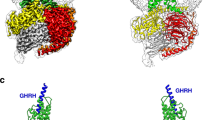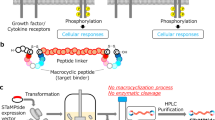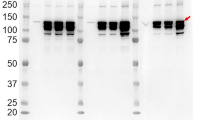Abstract
A growth hormone releasing factor analog [Leu27,Hse44]GRF(1–44)lactone has been made by recombinant DNA techniques. The peptide was expressed from a multiple–copied GRF gene fused to lacZ. The monomeric GRF peptide analog with a C–terminal homoserine lactone was obtained upon treatment of the isolated fusion protein with cyanogen bromide. The yield of the analog increased with the number of copies fused to β–galactosidase. The C–terminal homoserine moiety was chemically converted to the primary amide, [Leu27,Hse44]GRF(1–44)NH2 and also the n–butyl and n–dodecyl amides, [Leu27, Hse44]GRF(1–44)NHC4H9 and [Leu27,Hse44]GRF(1–44)NHC12H25. The primary amide exhibited a slightly higher releasing activity than the naturally occurring hpGRF(1–44)NH2 whereas the secondary amide analogs had lower activities.
This is a preview of subscription content, access via your institution
Access options
Subscribe to this journal
Receive 12 print issues and online access
$209.00 per year
only $17.42 per issue
Buy this article
- Purchase on Springer Link
- Instant access to full article PDF
Prices may be subject to local taxes which are calculated during checkout
Similar content being viewed by others
References
Hartley, J.L. and Gregori, T.J. 1981. Cloning multiple copies of a DNA segment. Gene 13:347–353.
Shen, S.-H. 1984. Multiple joined genes prevent product degradation in Escherichia coli. Proc. Natl. Acad. Sci. USA 81:4627–4631.
Kempe, T., Kent, S.B.H., Chow, F., Peterson, S.M., Sundquist, W.I., L'Italien, J.J., Harbrecht, D., Plunket, D., and DeLorbe, W.J. 1985. Multiple copy genes—Production and modification of monomeric peptides from large multimeric fusion proteins. Gene 39:239–245.
Guillemin, R., Brazeau, P., Bohlen, P., Esch, F., Ling, N., and Wehrenberg, W.B. 1982. Growth hormone releasing factor from a human pancreatic tumor that caused acromegali. Proc. Natl. Acad. Sci. USA 218:585–587.
Rivier, J., Spiess, J., Thorner, M., and Vale, W. 1982. Characterization of a growth hormone releasing factor from a human pancreatic islet tumour. Nature 300:276–278.
Ling, N., Esch, F., Bohlen, P., Brazeau, P., Wehrenberg, W.B., and Guillemin, R. 1984. Isolation, primary structure, and synthesis of human hypothalamic somatocrinin: Growth hormone-releasing factor. Proc. Natl. Acad. Sci. USA 81:4302–4306.
Baile, C.A., Della-Fera, M.A., and Buonomo, F.C. 1983. Growth hormone releasing factor (GRF) injections in sheep. J. Animal Sci. 57(suppl 1): 188.
Ohmura, E., Jansen, A., Chernick, V., Winter, J., Friessen, H.G., Rivier, J., and Vale, W. 1984. Human pancreatic growth hormone releasing factor hpGRF(1-40) stimulates GH release in the ovine fetus. Endocrinology 114:299–301.
Chow, F., Kempe, T., and Palm, G. 1981. Synthesis of oligodeoxyribonucleotides on silica gel support. Nucl. Acids Res. 9:2807–2817.
Beaucage, S.L. and Caruthers, M.H. 1981. Deoxynucleoside phosphoramidites—a new class of key intermediates for deoxypolynucleotide synthesis. Tetrahedron Lett. 22:1859–1862.
Grosjean, H. and Fiers, W. 1982. Preferential codon usage in prokaryotic genes: The optimal codon-anticodon interaction energy and the selective codon usage in efficiently expressed genes. Gene 18:199–209.
Watson, R.J., Weis, J.H., Salstrom, J.S., and Enquist, L.W. 1985. Expression of Herpes simplex virus type 1 and type 2 glycoprotein D genes using the Escherichia coli lac promoter, p. 327–352. In: Recombinant DNA Research and Viruses, T. Becker, (ed.). Martinus Nijhoff, The Hague.
Halling, S.M. and Smith, S. 1985. Expression in Escherichia coli of multiple products from a chimaeric gene fusion: evidence for the presence of procaryotic translational control regions within eucaryotic genes. Bio/Technology 3:715–720.
Casadaban, J.J. and Cohen, S.N. 1980. Analysis of gene control signals by DNA fusion and cloning in E. coli. J. Mol. Biol. 138:179–207.
Gross, E. and Witkop, B. 1961. Selective cleavage of the methionyl peptide bond in ribonuclease with cyanogen bromide. J. Amer. Chem. Soc. 83:1510–1511.
Gross, E. 1967. The cyanogen bromide reaction, p. 238–255. In: Methods in Enzymology, Vol. 11. C. H. W. Hirs (ed.). Academic Press, New York.
Tatemoto, K. and Mutt, V. 1978. Chemical determination of polypeptide hormones. Proc. Natl. Acad. Sci. USA 75:4115–4119.
Horn, M.J. 1975. Animation of carboxyl-terminal homoserine peptides as an aid in peptide separation. Analytical Biochem. 69:583–589.
Horn, M.J. and Laursen, R.A. 1973. Solid-phase Edman degradation: Attachment of carboxyl-terminal homoserine peptides to an insoluble resin. FEBS Lett. 36:285–288.
Dyckes, D.F., Kini, H., and Sheppard, R.C. 1976. Studies on the partial synthesis of protein analogs by direct coupling to terminal homoserine lactone derivatives. Int. J. Peptide Protein Res. 9:340–348.
The synthesis of [Hse31]salmon 1 calcitonin via a homoserine lactone, made by this technique, and proline amide has recently been accomplished (manuscript in preparation).
Bolivar, F., Rodriguez, R.L., Greene, P.J., Betlach, M.C., Heyneker, H.L., Boyer, H.W., Crosa, J.H., and Falkow, S. 1977. Construction and characterization of new cloning vehicles, II. A multi-purpose cloning system. Gene 2:95–113.
Lillehaug, J.R. and Kleppe, K. 1975. Effect of salts and polyamines on T4 polynucleotide kinase. Biochemistry 14:1225–1229.
Smith, H.O. 1980. Recovery of DNA from gels, p. 371–380. In: Methods in Enzymology, Vol. 65. L. Grossman and K. Moldave (eds.). Academic Press, New York.
Wieslander, L. 1979. A simple method to recover intact high molecular weight RNA and DNA from electrophoretic separation in low gelling temperature agarose gels. Anal. Biochem. 98:305–309.
Kushner, S.R. 1978. An improved method for transformation of Escherichia coli with Col E1 derived plasmids. Genetic Engineering, p. 17–29. H. W. Boyer and S. Nicosia (eds.). Elsevier/North, Amsterdam.
Birnboim, H.C. and Doly, J. 1979. A rapid alkaline extraction procedure for screening recombinant plasmid DNA. Nucl. Acids Res. 7:1513–1523.
Frischauf, S.M., Garoff, H., and Lehrach, H. 1980. A subcloning strategy for DNA sequence analysis. Nucl. Acids Res. 8:5541–5549.
Laemmli, U.K. 1970. Cleavage of structural proteins during the assembly of the head of bacteriophage T4. Nature 227:680–685.
Maizel, J.V., Jr. 1971. Polyacrylamide gel electrophoresis of viral proteins. Methods Virol. 5:180.
Author information
Authors and Affiliations
Rights and permissions
About this article
Cite this article
Kempe, T., Chow, F., Peterson, S. et al. Production and Characterization of Growth Hormone Releasing Factor Analogs Through Recombinant DNA and Chemical Techniques. Nat Biotechnol 4, 565–568 (1986). https://doi.org/10.1038/nbt0686-565
Received:
Accepted:
Issue Date:
DOI: https://doi.org/10.1038/nbt0686-565



